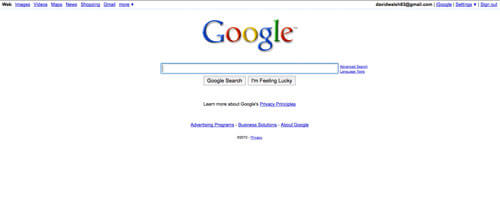Save Text Size Preference Using MooTools 1.2
This post was authored by Eric Wendelin. To learn more about Eric, click here.
Last time posting here I taught you how to change text-size with JavaScript. The problem with using the solution I presented as Ian Lloyd pointed out:
Increase the font size, follow a link to another web page on same site and … back to small text
Obviously, the problem here is that we don't remember the user's preferences. It turns out to be very easy using simple JavaScript and PHP. You can view the demo now if you like. For this example I'm going to use the new MooTools 1.2 beta to handle the "cookie jar" so I don't get my hand stuck in it :) OK, let's revise the JavaScript that does the text-sizing:
New and Improved resizeText():
function resizeText(multiplier)
{
var fontsz = "1.0em"; //Default to 1em
if (Cookie.get('site_font_size'))
{
// Use MooTools to get the cookie (if it exists)
fontsz = Cookie.get('site_font_size');
}
fontsz = parseFloat(fontsz) + (multiplier * 0.2) + "em"; // Change body text size
document.body.style.fontSize = fontsz; //Set a new cookie with MooTools
var myCookie = Cookie.set('site_font_size', fontsz, {
domain: 'mydomain.com',
duration: 365 //Save for 365 days
});
}
As you can see this function has grown up into a very useful utility that uses cookies to store and retrieve the value of the current font-size so that the user doesn't have to resize the text after every page load. We could just call resizeText(0) onload but that would cause a flicker on the user's screen and we do not tolerate that when we can do something about it. Using PHP prevents this from happening.
The PHP snippet:
<? echo 'body { font-size:',$_COOKIE['site_font_size'],'; }'; } ?>
Put this snippet immediately after your <link> and <style> tags to prevent any errors.
Now once you have it all ready to test out, I recommend using Firecookie (an extension to Firebug) to verify that it is working exactly as expected. I have a blog post that tells you about all of Firecookie's cool features.

About Eric Wendelin
Eric Wendelin is a software engineer for Sun Microsystems. When he’s not doing super-secret programming for Sun, he plays indoor soccer, playing Wii with his friends, and cheering on the Colorado Avalanche. He also writes a blog on JavaScript, CSS, Java, and Productivity at eriwen.com





Perfect with Mootools !
Thank you very much:)
No problem! MooTools makes it too easy!
Nice script – but IMO, this function should be left to the browser.
@Binny:
I totally agree, but this functionality is not yet handled properly by all browsers. Furthermore, certain websites have smaller font sizes as part of their design and this code here allows users to customize it for your site.
It is not the best solution by any means but I think it is a good one for now.
I make a reset body normal (French translation) :
function resizeText(multiplier) { var fontsz = "0.69em"; // Taille de base qui équivaut à 10px // Si l'on ne reset pas le css if(multiplier != 2) { if (Cookie.get('site_font_size')) { // Si le cookie existe déjà, on prends sa valeur fontsz = Cookie.get('site_font_size'); } fontsz = parseFloat(fontsz) + (multiplier * 0.2) + "em"; } else { var fontsz = "0.69em"; // Taille normal qui équivaut à 10px } // Changement de la taille du body document.body.style.fontSize = fontsz; // Mise à jour du cookie var myCookie = Cookie.set('site_font_size', fontsz, { domain: 'dbdreams.net', duration: 365 // 1 an }); }Firefox 3 > it doesn’t work, meaning I cannot change the text size…have you done something with the links meanwhile?
@Cosmin:
Oops! I upgraded Mootools from 1.2 beta to 1.2 final and they changed the API!
Page fixed, and thanks for letting me know!
cookie.get don’t work
@Geek34:
Yes, the Mootools Cookie class has changed since this was written. The correct functions are Cookie.read() and Cookie.write() respectively :)
Instead of using
document.body.style.fontSize = fontsz;you can use morph and change the default unit to em so its a smooth transition instead of the jump in size://set up morph var morphTextSize = new Fx.Morph(document.body,{duration:300,transition:Fx.Transitions.linear,'unit':'em'}); //set font size morphTextSize.start({ 'font-size': parseFloat(fontsz) + (multiplier * 0.2) });There seems to be an error with the way your blog parsed the domain on line 13. For a JS newb like me it was a little confusing for a moment :P
@Andy: Line 13 is fine. What error?
I tried to implement it with jquery and radSlider ASP.NET control. But i reach some problems. After I read comments, and figure out, that best solutions is make “fake” button for text size changing, which shows bubble with something like “Wanna change text size – try CTRL + mouse wheel and if it doesn’t work get better browser”… That’s best solution IMO :)
Hi,
I would like to target by
IDadiv(eg the ‘content’divin your example) and change just the text size of this when the button is clicked, and not all of the text.How would I amend the following line to do this?
I’ve tried –
document.body.getElementById("content") = fontsz;but that didn’t seem to work.Any help would be greatly appreciated
Thanks,
Richard
Richard:
You’ll want something like
document.getElementById('content').style.fontSize = fontsz;Let me know if that doesn’t work for you. Cheers, Eric
Great Post! I was wondering if there is a way to automatically detect the domain to make this script more portable?
Thanks!
Best,
Matt
Thanks, Matt.
You can use
window.location.hostto get the current domain.Cheers,
Eric
I swear noone has tried the PHP-snippet, as its obviously sooo wrong, uah.
Try this one